Abstract
Lightcurves for 40 asteroids were obtained at the Palmer Divide Observatory (PDO) from 2012 September to 2013 January: 495 Eulalia, 1694 Kaiser, 2001 Einstein, 3086 Kalbaugh, 3635 Kreutz, 5806 Archieroy, 6310 Jankonke, 6447 Terrycole, 6744 Komoda, 7086 Bopp, 7560 Spudis, 8325 Trigo-Rodriguez, 11149 Tateshina, 11709 Eudoxos, (13245) 1998 MM19, (13573) 1993 FZ18, 14395 Tommorgan, 15434 Mittal, (17657) 1996 VO4, (22013) 1999 XO89, (26916) 1996 RR2, 27776 Cortland, (30878) 1992 GQ, (30981) 1995 SJ4, (31831) 1999 YL, (32626) 2001 RX64, (51371) 2000 XF15, 55844 Bicak, (55854) 1996 VS1, (63440) 2001 MD30, (66832) 1999 UE45, (70927) 1999 VX210, (72675) 2001 FP54, (86388) 2000 AT60, (90988) 1997 XS13, (123937) 2001 EX16, (136017) 2002 VH74, (192683) 1999 SO27, (330825) 2008 XE3, and 2012 TC4. Based on data and analysis in 2012 for 27776 Cortland, the previously reported period from 2009 has been revised.
CCD photometric observations of 40 asteroids were made at the Palmer Divide Observatory (PDO) from 2012 September to 2013 January. See the introduction in Warner (2010c) for a discussion of equipment, analysis software and methods, and overview of the lightcurve plot scaling. The “Reduced Magnitude” in the plots is Johnson V or Cousins R (indicated in the Y-axis title) corrected to unity distance by applying −5*log (rΔ) to the measured sky magnitudes with r and Δ being, respectively, the Sun-asteroid and Earth-asteroid distances in AU. The magnitudes were normalized to the phase angle given in parentheses, e.g., alpha(6.5°), using G = 0.15, unless otherwise stated.
For the sake of brevity in the following discussions on specific asteroids, only some of the previously reported results may be referenced. For a more complete listing, the reader is referred to the asteroid lightcurve database (LCDB, Warner et al., 2009). The on-line version allows direct queries that can be filtered a number of ways and the results saved to a text file. A set of text files, including the references with bibcodes, is also available for download at http://www.minorplanet.info/lightcurvedatabase.html. Readers are strongly encouraged to obtain, when possible, the original references listed in the LCDB for their work.
495 Eulalia
The rotation period for this 40 km Nysa member was first measured by Binzel (1987) at 29.2 h. Behrend (2005) reported a period of 28 hours. It was observed at PDO in 2012 November and December at the request of another researcher.
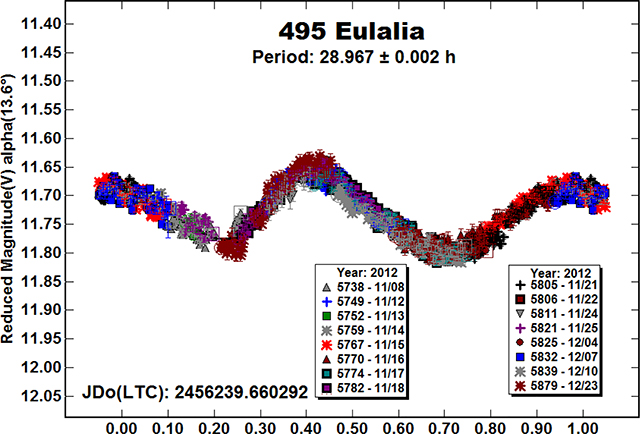
Almost 1200 data points were obtained using a V filter. The AAVSO Photometric All-Sky Survey (APASS; Henden et al., 2012) catalog was used to fix the magnitudes of comparison stars in each field. Analysis of the data found a synodic period of 28.967 ± 0.002 h and amplitude of 0.14 ± 0.01 mag. The phase angle of the observations ranged from about 2° to 13°. This allowed finding the absolute magnitude (H) and phase slope parameter (G), i.e., H = 10.95 ± 0.02 and G = 0.20 ± 0.03.

1694 Kaiser
The author worked this inner main-belt asteroid in 2006, finding a period of 13.23 h (Warner, 2006). Analysis of the 2012 data found P = 13.02 ± 0.01 h, A = 0.32 ± 0.02 mag. The larger amplitude and higher-quality data in 2012 favor the shorter period. Kaiser was not a planned target in 2012 but appeared in the field with a project asteroid, making it a so-called “target of opportunity,” a common trait for a number of other asteroids in this work.
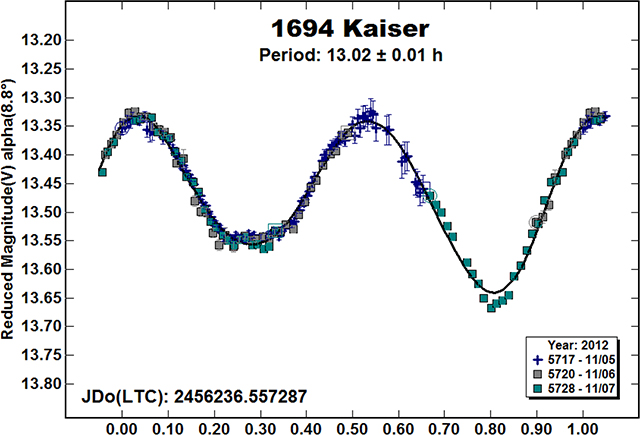
2001 Einstein
This is the fourth apparition at which this Hungaria was worked at PDO. Previous results (Warner, 2005b; 2008c; 2010b) found nearly identical periods. However, the amplitude has ranged from 0.66 mag (2004) to 1.02 mag (2008).
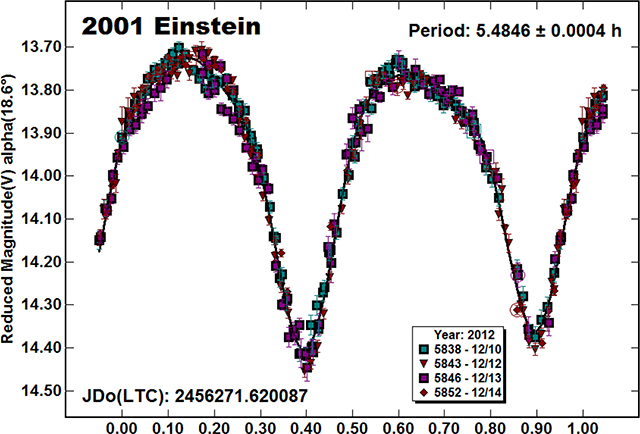
3086 Kalbaugh
Previous results by the author (Warner, 2005b; 2008b; 2010b) agree with the period of P = 5.179 ± 0.005 h found in the 2012 analysis. Here, too, a significant range of amplitudes has been seen over the years, 0.47–0.76 mag.
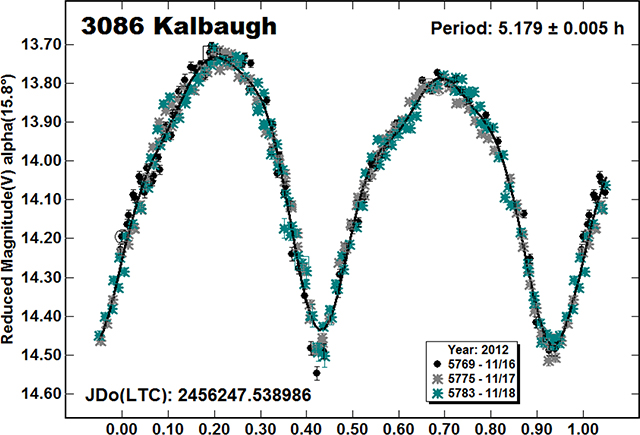
3635 Kreutz
Analysis of the 2012 data found a period of about 280 h with an amplitude of 0.25 mag. An approximate rule of thumb using this period (Pravec et al., 2005) gives a tumbling damping time well in excess of the age of the Solar System for this Hungaria. However, there were no obvious signs of tumbling in the data, e.g., the lightcurve not repeating itself on a second cycle or data from a given night having the “wrong” sense of direction, i.e., trending up when down was expected.
These results do not agree with the P = 39 h previously reported by the author (Warner, 2006). The images from that earlier apparition were re-measured using the Comp Star Selector in MPO Canopus (as was done in 2012). This allows calibrating night-to-night observations to ± 0.05 mag. The new data showed no definitive period or trend within a given night, save 2005 Dec 8, which seemed to show an increase of about 0.04 mag over about 8 hours. The observing conditions in 2005 were poor on all four nights, which may contribute to the uncertainty of the results. Given the available data, the correct period is likely on the order of 280 hours.

5806 Archieroy
Analysis of the 2012 data found P = 12.1602 ± 0.0005 h, A = 0.47 ± 0.02 mag. The period agrees with previous results by the author (Warner, 2005a; 2008b).

6310 Jankonke
Previous results, all about 3.04 h, are from Warner (2005b; 2011) and Behrend (2008). However, the author found a period of 3.08 h in 2008 (Warner, 2008b). The 2012 PDO analysis found P = 3.076 ± 0.002 h, A = 0.10 ± 0.01 mag. It should be noted that the data sets from 2008 and 2012 are of much higher quality than the other sets obtained at PDO and that the 2005 data set has two, nearly equal solutions, one of them being 3.074 h.

6447 Terrycole
The author found a period of 10.278 h in 2009 (Warner, 2010a) using somewhat noisy data from five nights. The 2012 data set covered three consecutive nights but was of higher quality. Analysis of the 2012 data found P = 10.268 h. Observations at future apparitions are needed to resolve the slight discrepancy in results.

6744 Komoda
This was a target of opportunity that was followed on a second night, thus providing a secure result.

7086 Bopp
Warner (2008a) found P = 29.0 h while Behrend (2006) reported P = 3.40 h. The 2012 data analysis found a period of 29.15 ± 0.02 h.
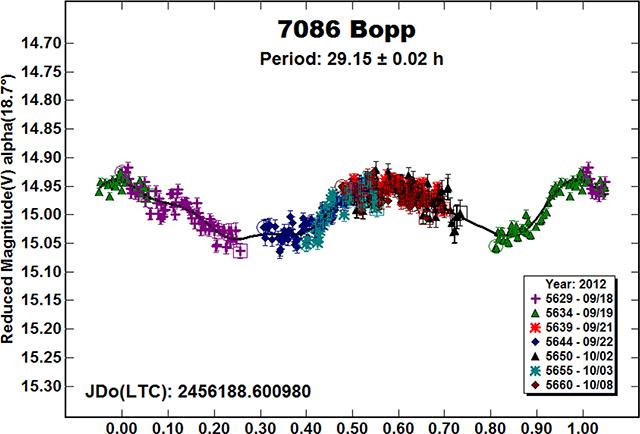
7560 Spudis
This asteroid was observed twice before, in 2004 and (Warner, 2008b). The results then and in 2012 were in excellent agreement. On the other hand, the amplitude in 2012 was 0.38 mag, significantly larger than in the previous apparitions (0.17 mag, 2004; 0.10 mag, 2008).

8325 Trigo-Rodriguez
This outer main-belt asteroid was a one-night target of opportunity. No period could be found, the data showing only a very slight decrease in magnitude over the span of the observations.


11149 Tateshina
Two nights of follow-up on this target of opportunity, a Vestoid of about 5 km effective diameter, allowed finding a secure solution.
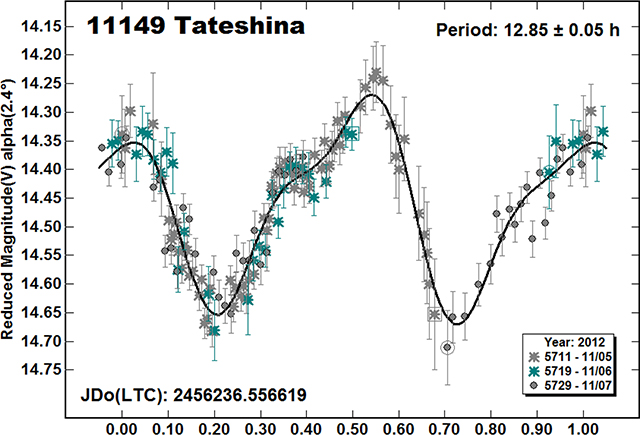
11709 Eudoxos
This middle main-belt object was in the same field as a planned target for two nights. Unfortunately, it was faint and so the data have large errors. The result of P = 2.64 h should not be considered secure.
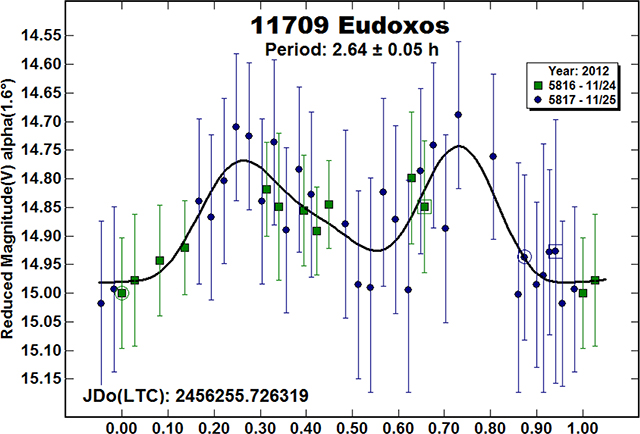
(13245) 1998 MM19
The long northern winter nights allowed covering the 4.664 h period of this Hungaria member more than once on each of two nights, making for a secure solution.

(13573) 1993 FZ18
Despite three nights of observations in 2012 November, a low amplitude combined with error bars greater than the amplitude prevented finding a unique solution. Two plots are presented, one each for the dominant periods of 3.06 and 6.12 h found during the analysis. This is a Flora member and was a target of opportunity.


(14395) Tommorgan
The plot shows a very confused lightcurve. This is because the asteroid is a “tumbler”, i.e., in non-principal axis rotation (see Pravec et al., 2005). The data are phased to the dominant period of 35.5 h. Petr Pravec (private communications) found a second, non-unique period of 40.4 h. A definitive result would require an extended campaign by an extended group of observers.

(15434) Mittal
This Flora member was another target of opportunity. The large error bars, ~0.05 mag, were offset by the amplitude of 0.65 mag and so a secure solution could be found.
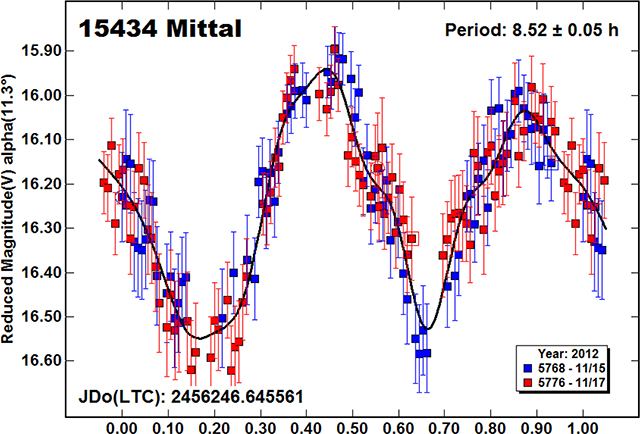
(17657) 1996 VO4
A total of 206 data points were used in the analysis for this Hungaria member. The result was a period of 5.507 ± 0.005 h and amplitude of 0.53 ± 0.02 mag.

(22013) 1999 XO89
Data for this outer main-belt asteroid were obtained on a single night, 2012 Nov 12, the asteroid being another target of opportunity. There was no follow-up because of an already busy list of targets, planned and not, and because the solution of 6.5 ± 0.3 h was considered secure enough to be statistically valid for rotation rate studies.

(26916) 1996 RR2
The period of 10.326 ± 0.005 h found with the 2012 data agrees well with earlier results by the author (Warner, 2008b; 2010a).
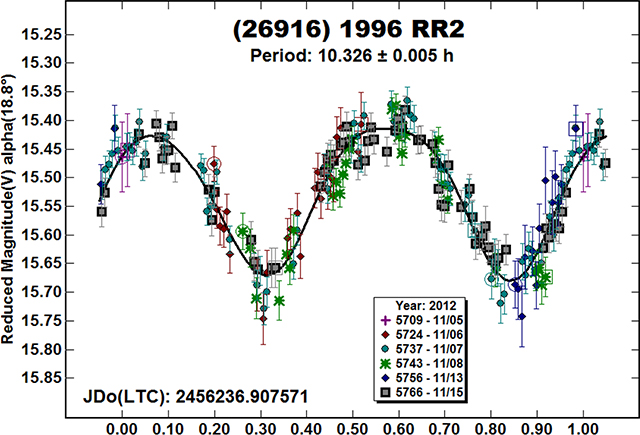
(27776) Cortland
This Hungaria was first observed at PDO in (Warner, 2010a). At that time, a period of 20.50 h was reported with an amplitude of 0.09 mag. The 2012 data also showed a low amplitude lightcurve but, with better night-to-night calibrations, a much shorter period of 2.6095 ± 0.0003 h was found. The 2009 were re-examined and found to fit a period of 2.6104 ± 0.0004 h, making the two results statistically the same. The phase angle bisector longitudes (LPAB) of the two apparitions differ by about 70°, and so it appears that this asteroid may always present a low amplitude lightcurve. Follow-up observations are encouraged to confirm this supposition.


(30878) 1992 GQ
There were no previously reported results in the LCDB for this outer main-belt asteroid, yet another target of opportunity. As much as possible, these serendipitous initial observations are followed-up to determine a reasonably secure solution. This helps avoid adding to observational biases against fainter targets. On the other hand, such follow-up is more likely when the initial data indicate a relatively short period and moderate to large amplitude, thus adding to existing biases favoring “easy” targets.

(30981) 1995 SJ4
This outer main-belt asteroid is just such an example of an “easy” target. It was a target of opportunity that was given dedicated follow-up because the period, amplitude and shape of the lightcurve made it a potential small binary candidate. When the initial results fall into the range where a binary is possible, then whenever possible the object is followed for at least three nights to check for evidence of a satellite via eclipse or occultation events. No such evidence was seen in this case.
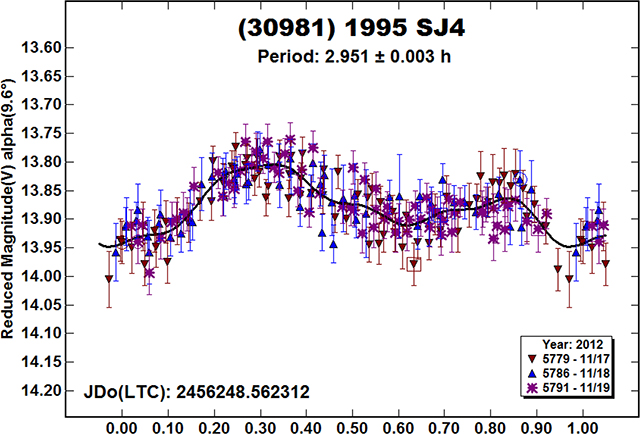
(31831) 1999 YL
The initial results for this Hungaria made it a binary candidate and so it was observed on four nights. Nothing unusual was seen in 2012 but the asteroid should be observed at future apparitions. Some binary asteroids were found only on second and even third tries at different apparitions.
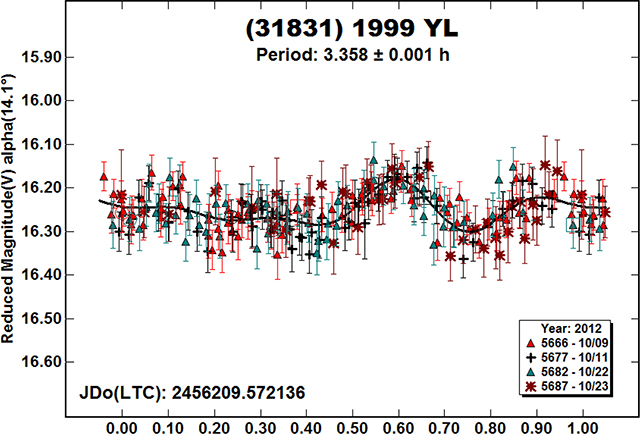
(32626) 2001 RX64
Since this was a target of opportunity and the analysis of the one night (2012 Nov 7) provided a reasonably secure result of P = 6.23 ± 0.05 h and A = 0.43 ± 0.03 mag, no follow-up was scheduled.
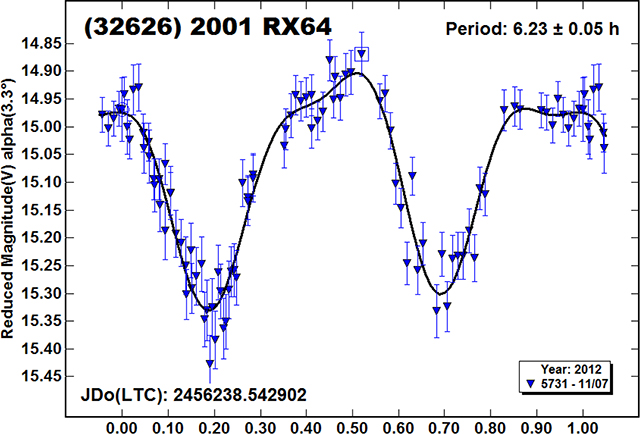
(51371) 2000 XF15
This Hungaria was observed for seven consecutive nights (2012 Nov 19–25). A definitive solution could not be found; two possible results are 54 and 112 h with an amplitude of about 0.10 mag. Plots showing the data phased to each of the periods are included below.


(55844) Bicak
Early observations of this Hungaria showed faint deviations from a lightcurve with a period of 2.8052 ± 0.0002 h. Here again, the period, amplitude, and shape were “binary friendly” and so the asteroid was observed for a total of 10 nights from 2012 Sep 10 to Oct 03. Nothing substantial was seen in the later observations. The asteroid will be a priority target at its next apparition visible from PDO.
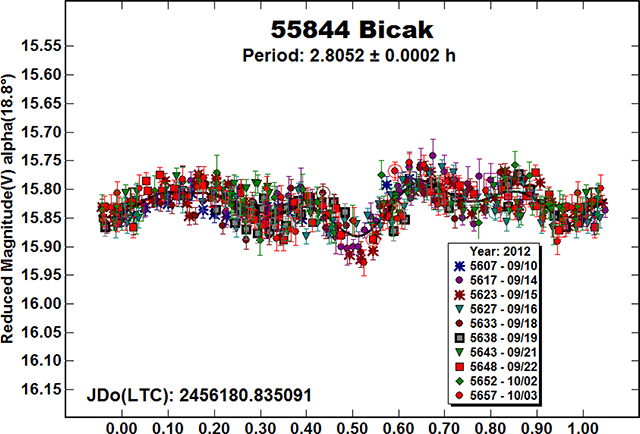
(55854) 1996 VS1
Warner (2011) and Skiff (2011) observed this Hungaria asteroid in 2011, finding periods of 3.067 and 3.064 h, respectively. Follow-up observations at PDO in 2012 November confirmed those earlier results within 1-sigma errors.
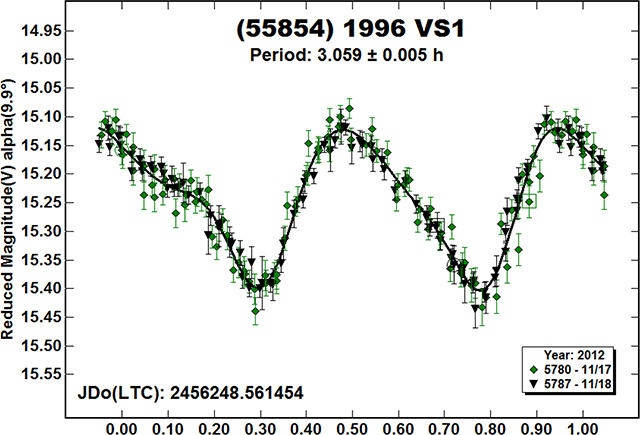
(63440) 2001 MD30
A result of P = 3.29687 h for this Hungaria was reported by Pravec et al. (2010) based on data obtained in 2009. Additional results posted on Pravec’s web site (2012) using data from 2012 October showed P = 3.2968 h. The PDO results using data from 2012 November found P = 3.2940 h.

(66832) 1999 UE45
This middle main-belt asteroid was a one-night target of opportunity. The solution is reasonably secure but future follow-up is encouraged.
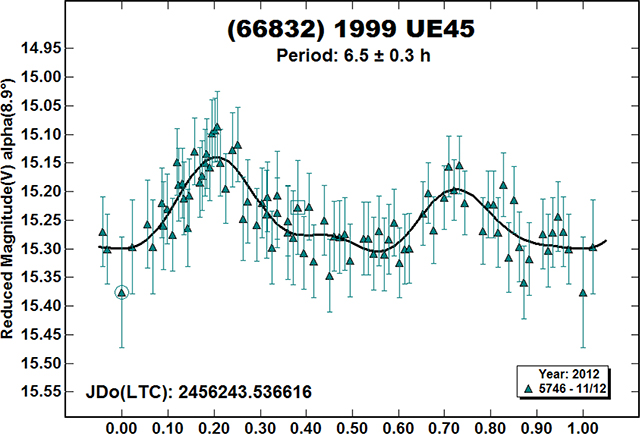
(70927) 1999 VX210
This was another middle main-belt, one-night target of opportunity. The large amplitude allows some confidence in the period but the incomplete lightcurve argues somewhat against it.

(72675) 2001 FP54
Confidence in the solution of P = 2.50 ± 0.05 h is justified by the 0.38 mag amplitude, which requires a bimodal lightcurve at low phase angles (Harris, 2012). This outer main-belt resident was a one-night target of opportunity.

(86388) 2000 AT60
A member of the Flora group, this target of opportunity was given two additional nights of follow-up with the hope of overriding the noisy data with sufficient data to find a useful solution. That goal was barely achieved, finding a period of 10.23 h.

(90988) 1997 XS13
The solution of P = 8.8 ± 0.5 h for this inner main-belt target of opportunity should be viewed as tentative, with follow-up to be made whenever possible.

(123937) 2001 EX16
Eight nights of observations of this Hungaria asteroid failed to produce a secure solution. A period of 39.82 h and amplitude of 0.07 mag fit the data, but the lightcurve is not complete and the RMS fit to the Fourier curve is poor. The observations covered phase angles ranging from 6° to 22°. Accordingly, the data were used to find H-G parameters of H = 16.04 ± 0.10 and G = 0.51 ± 0.13. The latter is consistent with a high albedo object, as are members of the Hungaria family.
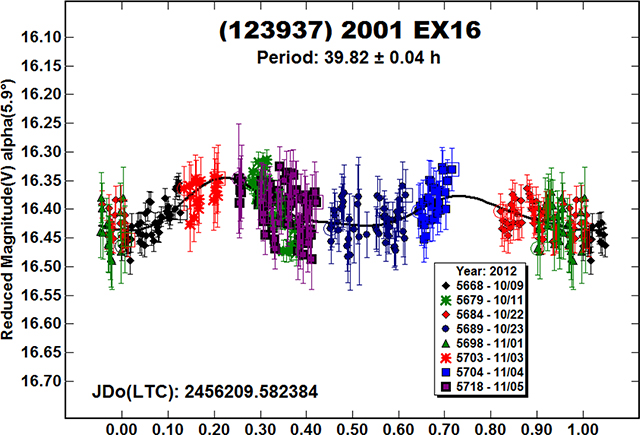
(136017) 2002 VH74
The solution of 4.3 h for this outer main-belt target of opportunity is not secure despite the apparent amplitude of 0.35 mag since the error bars are a significant portion of the amplitude.

(192683) 1999 SO27
Two possible solutions were found for this Eunomia asteroid. A monomodal lightcurve has P = 13.17 ± 0.07 h, A = 0.14 ± 0.03 mag while a bimodal solution gives P = 26.45 ± 0.25 h, A = 0.22 ± 0.03 mag.
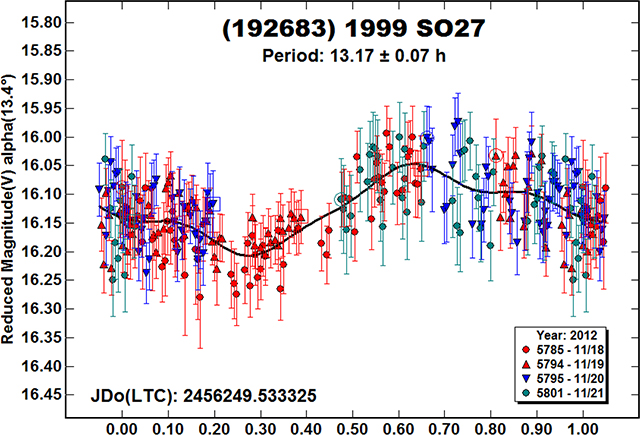
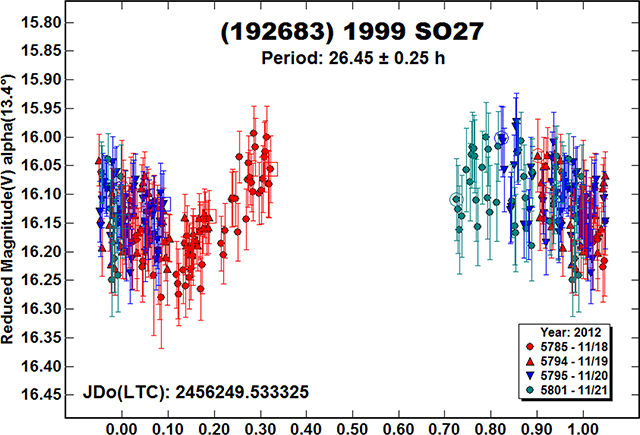
(330825) 2008 XE3
Using data from 2012 November, Hicks et al. (2012) reported P = 4.412 h, A = 0.15 mag at a phase angle of about 22°. The NEA was observed a month earlier at PDO, at phase angle ~39°. Analysis of that data found P = 4.409 h and A = 0.22 mag. The larger amplitude of the PDO data is expected with the larger phase angle.

2012 TC4
This NEA was observed on one night, 2012 Oct 11, during a close fly-by to Earth. The PDO data lead to a period of 0.2038 ± 0.0002 h (about 12.2 minutes) with an amplitude of 0.93 ± 0.05 mag. These results agree well with those reported by Polishook et al. (2013).
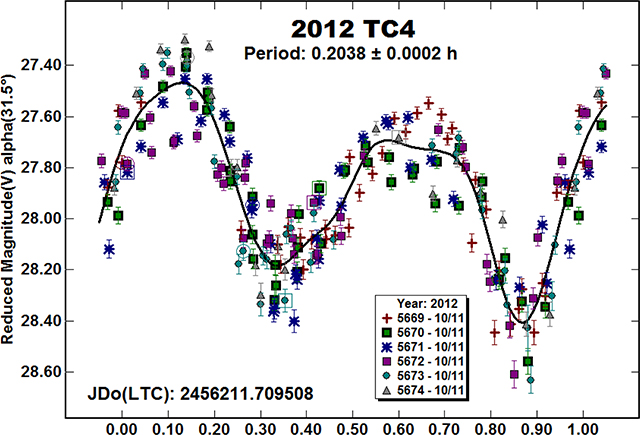
Table I.
Observing circumstances. Asteroids with (H) after the name are members of the Hungaria group/family. The phase angle (α) is given at the start and end of each date range, unless it reached a minimum, which is then the second of three values. If a single value is given, the phase angle did not change significantly and the average value is given. LPAB and BPAB are each the average phase angle bisector longitude and latitude, unless two values are given (first/last date in range).
| Number | Name | 2012/13 (mm/dd) | Pts | Phase | LPAB | BPAB | Period | P.E. | Amp | A.E. |
|---|---|---|---|---|---|---|---|---|---|---|
| 495 | Eulalia | 11/08–12/23 | 1181 | 13.7,1.7,10.2 | 71 | −3 | 28.967 | 0.002 | 0.14 | 0.01 |
| 1694 | Kaiser | 11/05–11/07 | 183 | 8.6,9.7 | 33 | +7 | 13.02 | 0.01 | 0.32 | 0.02 |
| 2001 | Einstein (H) | 12/10–12/14 | 316 | 18.5,18.4 | 84 | +32 | 5.4846 | 0.0004 | 0.67 | 0.02 |
| 3086 | Kalbaugh (H) | 11/16–11/18 | 339 | 15.8,15.6 | 59 | +25 | 5.179 | 0.005 | 0.76 | 0.02 |
| 3635 | Kreutz (H) | 10/31–11/14 | 505 | 18.2,24.2 | 18 | +13 | 280. | 5. | 0.25 | 0.03 |
| 5806 | Archieroy (H) | 10/02–10/23 | 469 | 19.0,22.2 | 7 | +29 | 12.1602 | 0.0005 | 0.47 | 0.02 |
| 6310 | Jankonke (H) | 11/21–11/24 | 123 | 10.1,10.0 | 58 | −14 | 3.076 | 0.002 | 0.10 | 0.01 |
| 6447 | Terrycole (H) | 11/15–11/17 | 295 | 5.4, 4.4 | 59 | −3 | 10.268 | 0.006 | 0.24 | 0.02 |
| 6744 | Komoda | 11/19–11/20 | 180 | 2.3,2.0 | 60 | −4 | 3.110 | 0.005 | 0.40 | 0.02 |
| 7086 | Bopp (H) | 09/18–10/08 | 430 | 18.6,22.1 | 349 | +21 | 29.15 | 0.02 | 0.10 | 0.01 |
| 7560 | Spudis (H) | 09/22–10/08 | 274 | 19.6,19.5,20.3 | 6 | +26 | 3.5440 | 0.0002 | 0.38 | 0.02 |
| 8325 | Trigo-Rodriguez | 11/07 | 48 | 2.3 | 40 | +5 | Long | >0.05 | ||
| 11149 | Tateshina | 11/05–11/07 | 144 | 2.3,2.8 | 41 | +4 | 12.85 | 0.05 | 0.42 | 0.02 |
| 11709 | Eudoxos | 11/24–11/25 | 40 | 1.5,1.8 | 60 | −3 | 2.64 | 0.05 | 0.24 | 0.05 |
| 13245 | 1998 MM19 (H) | 10/09–10/11 | 133 | 4.5,5.6 | 9 | +2 | 4.664 | 0.005 | 0.28 | 0.02 |
| 13573 | 1993 FZ18 | 11/18–11/20 | 154 | 7.6,8.5 | 41 | −4 | 3.06/6.12 | 0.03 | 0.07 | 0.01 |
| 14395 | Tommorgan (H) | 11/05–12/07 | 963 | 9.2,24.6 | 40 | +15 | 35.51 | 0.5 | 0.61 | 0.05 |
| 15434 | Mittal | 11/15–11/17 | 168 | 11.4,10.3 | 71 | −3 | 8.52 | 0.05 | 0.65 | 0.03 |
| 17657 | 1996 VO4 (H) | 11/14–11/16 | 206 | 4.7,5.9 | 46 | −3 | 5.507 | 0.005 | 0.53 | 0.02 |
| 22013 | 1999 XO8 9 | 11/06 | 70 | 5.6 | 32 | +8 | 6.5 | 0.3 | 0.20 | 0.03 |
| 26916 | 1996 RR2 (H) | 11/05–11/15 | 201 | 18.8,18.5 | 49 | +31 | 10.326 | 0.005 | 0.27 | 0.02 |
| 27776 | Cortland (H) | 12/12–12/22 | 536 | 21.2,21.0 | 81 | +29 | 2.6095 | 0.0003 | 0.07 | 0.01 |
| 27776 | Cortland (H) | 08/17–08/29* | 391 | 13.6,8.2 | 342 | +7 | 2.6104 | 0.0004 | 0.05 | 0.01 |
| 30878 | 1992 GQ | 12/18–12/22 | 140 | 2.5,3.9 | 81 | −3 | 3.655 | 0.005 | 0.22 | 0.02 |
| 30981 | 1995 SJ4 | 11/17–11/19 | 202 | 9.5,10.0 | 37 | +15 | 2.951 | 0.003 | 0.14 | 0.02 |
| 31831 | 1999 YL (H) | 10/09–10/23 | 234 | 14.0,17.0 | 7 | +20 | 3.36 | 0.01 | 0.12 | 0.02 |
| 32626 | 2001 RX6 4 | 11/07 | 91 | 3.2 | 41 | +5 | 6.23 | 0.05 | 0.43 | 0.03 |
| 51371 | 2000 XF15 (H) | 11/19–11/25 | 290 | 3.1,2.6 | 60 | −3 | 54/112 | 5 | 0.09 | 0.01 |
| 55844 | Bicak (H) | 09/10–10/03 | 416 | 18.8,21.4 | 352 | +27 | 2.8052 | 0.0002 | 0.10 | 0.01 |
| 55854 | 1996 VS1 (H) | 11/17–11/18 | 187 | 9.7,10.3 | 42 | −3 | 3.059 | 0.005 | 0.28 | 0.02 |
| 63440 | 2001 MD30 (H) | 11/01–11/06 | 319 | 7.3,9.2 | 33 | +7 | 3.2940 | 0.0006 | 0.14 | 0.01 |
| 66832 | 1999 UE 4 5 | 11/12 | 83 | 8.8 | 38 | +14 | 6.5 | 0.3 | 0.16 | 0.02 |
| 70927 | 1999 VX210 | 11/07 | 57 | 2.9 | 41 | +5 | 6.6 | 0.3 | 0.60 | 0.03 |
| 72675 | 2001 FP5 4 | 11/12 | 58 | 4.7 | 40 | +6 | 2.50 | 0.05 | 0.38 | 0.03 |
| 86388 | 2000 AT60 | 12/21–01/02 | 112 | 5.3,11.7 | 82 | −3 | 10.23 | 0.02 | 0.26 | 0.03 |
| 90988 | 1997 XS13 | 12/18 | 58 | 3.6 | 81 | −3 | 8.8 | 0.5 | 0.14 | 0.02 |
| 123937 | 2001 EX16 (H) | 10/09–11/05 | 332 | 5.7,22.5 | 14 | +10 | 39.82 | 0.04 | 0.07 | 0.01 |
| 136017 | 2002 VH7 4 | 11/20 | 79 | 1.8 | 60 | −4 | 4.3 | 0.2 | 0.35 | 0.05 |
| 192683 | 1999 SO27 | 11/18–11/21 | 244 | 13.2,14.2 | 39 | +15 | 13.172 | 0.072 | 0.142 | 0.03 |
| 330825 | 2008 XE3 | 10/02–10/08 | 299 | 39.7,37.5 | 34 | +19 | 4.409 | 0.001 | 0.22 | 0.02 |
| 2012 TC4 | 10/11 (7 UT) | 211 | 32.1 | 2 | +2 | 0.2038 | 0.0002 | 0.93 | 0.05 |
2009
Tumbler, dominant period given
Alternate solution: P=26.45±0.25h, A=0.22±0.03mag.
Acknowledgments
Funding for observations at the Palmer Divide Observatory is provided by NASA grant NNX10AL35G, by National Science Foundation grant AST-1032896.
References
- Behrend R (2005). Observatoire de Geneve web site, http://obswww.unige.ch/~behrend/page_cou.html
- Behrend R (2006). Observatoire de Geneve web site, http://obswww.unige.ch/~behrend/page_cou.html
- Behrend R (2008). Observatoire de Geneve web site, http://obswww.unige.ch/~behrend/page_cou.html
- Binzel RP (1987). “A photoelectric survey of 130 asteroids” Icarus 72, 135–208. [Google Scholar]
- Harris AW (2012). “On the Maximum Amplitude of Harmonics of an Asteroid Lightcurve.” in Proceedings for the 31st Annual Symposium on Telescope Science (Warner BD, Buchheim RK, Foote JL, Mais D, eds.) pp 59–63. Society for Astronomical Sciences. Rancho Cucamonga, CA. [Google Scholar]
- Henden AA, Smith TC, Levine SE, and Terrell D (2012). “The AAVSO Photometric All-Sky Survey Completes the Sky.” AAS Meeting #220, #133.06. [Google Scholar]
- Hicks M, Dombroski D, and Brewer M (2012). Astronomer’s Telegram 4591 http://www.astronomerstelegram.org
- Polishook D (2013). “Fast Rotation of the NEA 2012 TC4 Indicates a Monolithic Structure.” Minor Planet Bul. 40, 42–43. [Google Scholar]
- Pravec P, Harris AW, Scheirich P, Kušnirák P, Šarounová L, Hergenrother CW, Mottola S, Hicks MD, Masi G, Krugly Yu. N., Shevchenko VG, Nolan MC, Howell ES, Kaasalainen M, Galád A, Brown P, Degraff DR, Lambert JV, Cooney WR, and Foglia S (2005). “Tumbling Asteroids.” Icarus 173, 108–131. [Google Scholar]
- Pravec P, Vokrouhlický D, Polishook D, Scheeres DJ, Harris AW, Galád A, Vaduvescu O, Pozo F, Barr A, Longa P, Vachier F, Colas F, Pray DP, Pollock J, Reichart D, Ivarsen K, Haislip J, Lacluyze A, Kušnirák P, Henych T, Marchis F, Macomber B, Jacobson SA, Krugly Yu.N., Sergeev AV, and Leroy A(2010). “Formation of asteroid pairs by rotational fission.” Nature 466, 1085–1088. [DOI] [PubMed] [Google Scholar]
- Pravec P (2012). NewRes web page. http://www.asu.cas.cz/~ppravec/newres.txt
- Skiff BA (2011). Posting on CALL web site. http://www.minorplanet.info/call.html
- Warner BD (2005a). “Asteroid lightcurve analysis at the Palmer Divide Observatory - fall 2004.” Minor Planet Bul. 32, 29–32. [PMC free article] [PubMed] [Google Scholar]
- Warner BD (2005b). “Asteroid lightcurve analysis at the Palmer Divide Observatory - winter 2004–2005.” Minor Planet Bul. 32, 54–58. [PMC free article] [PubMed] [Google Scholar]
- Warner BD (2006). “Asteroid lightcurve analysis at the Palmer Divide Observatory - late 2005 and early 2006.” Minor Planet Bul. 33, 58–62. [PMC free article] [PubMed] [Google Scholar]
- Warner BD (2008a). “Asteroid Lightcurve Analysis at the Palmer Divide Observatory: September-December 2007.” Minor Planet Bul. 35, 67–71. [PMC free article] [PubMed] [Google Scholar]
- Warner BD (2008b). “Asteroid Lightcurve Analysis at the Palmer Divide Observatory: December 2007 - March 2008.” Minor Planet Bul. 35, 95–98. [PMC free article] [PubMed] [Google Scholar]
- Warner BD (2008c). “Asteroid Lightcurve Analysis at the Palmer Divide Observatory: February-May 2008.” Minor Planet Bul. 35, 163–167. [PMC free article] [PubMed] [Google Scholar]
- Warner BD (2010a). “Asteroid Lightcurve Analysis at the Palmer Divide Observatory: 2009 June-September.” Minor Planet Bul. 37, 24–27. [PMC free article] [PubMed] [Google Scholar]
- Warner BD (2010b). “Asteroid Lightcurve Analysis at the Palmer Divide Observatory: 2009 September-December.” Minor Planet Bui. 37, 57–64. [Google Scholar]
- Warner BD (2010c). “Asteroid Lightcurve Analysis at the Palmer Divide Observatory: 2010 March – June.” Minor Planet Bui. 37, 161–165. [Google Scholar]
- Warner BD (2011). “Asteroid Lightcurve Analysis at the Palmer Divide Observatory: 2011 March – July.” Minor Planet Bui. 38, 190–195. [Google Scholar]
- Warner BD, Harris AW, and Pravec P (2009) “The Asteroid Lightcurve Database.” Icarus 202, 134–146. [Google Scholar]


